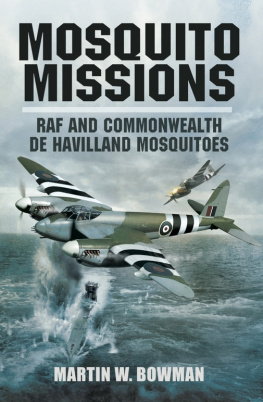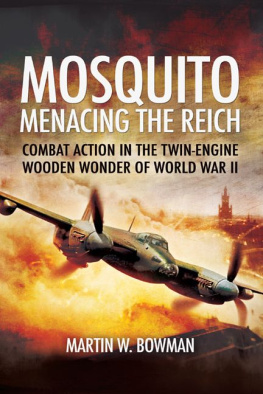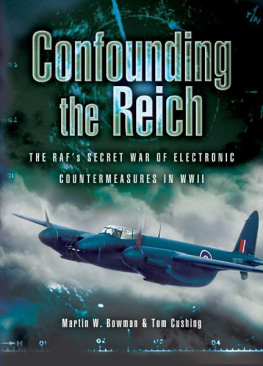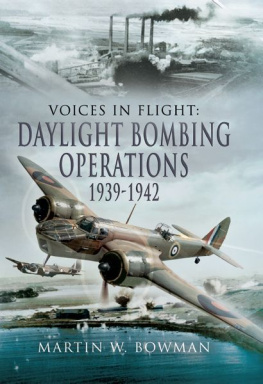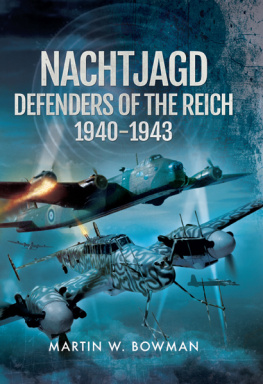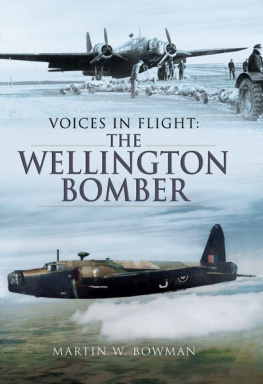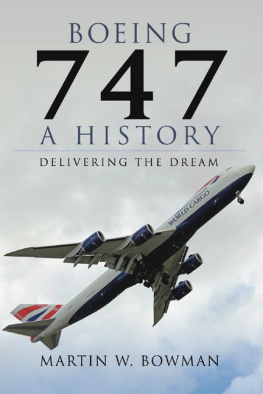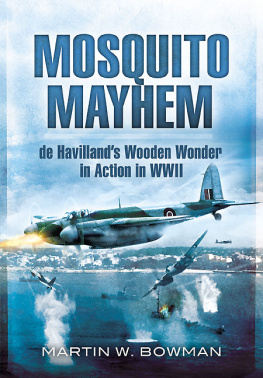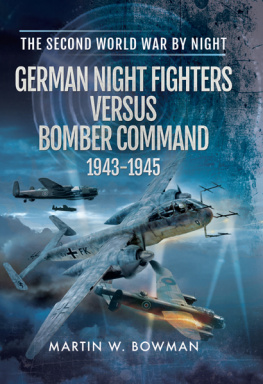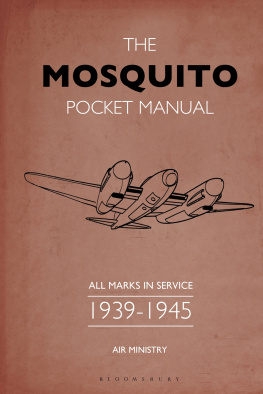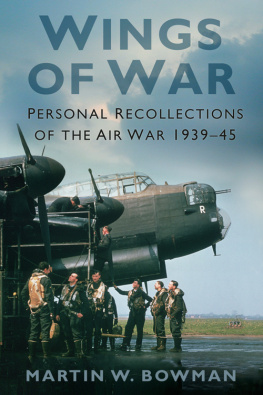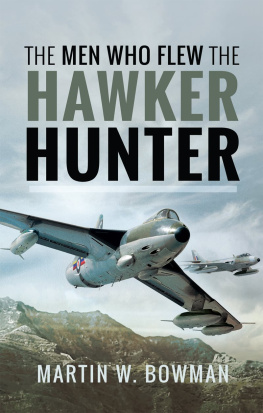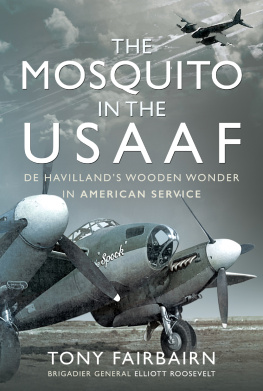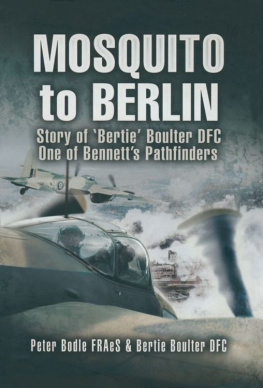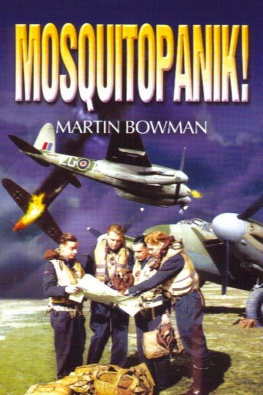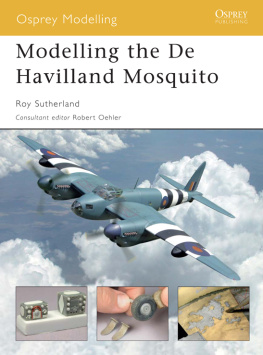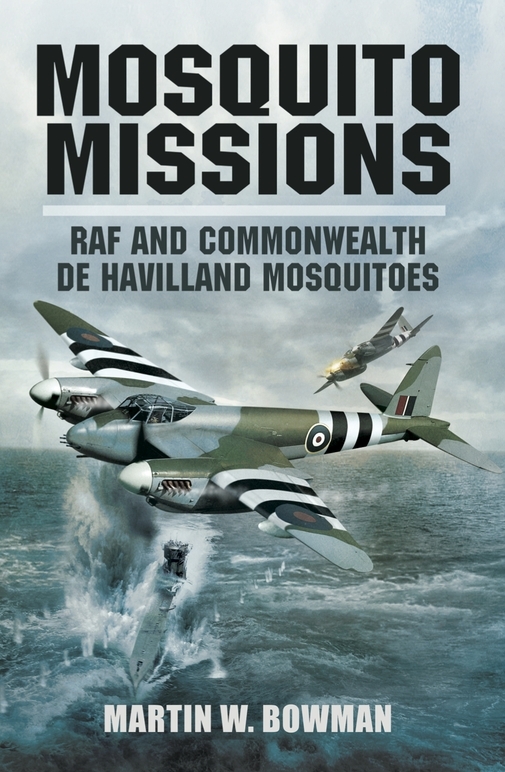I am enormously grateful to the following people for their time and effort and kind loan of photos etc, not least to my fellow Mosquito author, friend and colleague, Graham Simons, for getting the book to press-ready standard: Eric Atkins DFC* KW*, Chairman MAA; Michael H. A. T. Bayon DFC; Andy Bird; Philip J. Birtles; Barry Blunt BA Hons; Dr. Theo Boiten; Bill Bridgeman; Tommy Broom DFC**; Derek Carter; George Cash; Peter Celis; Johnny Claxton; Bob Collis; Squadron Leader Joe Cooper AFC FC; Hank Cooper DSO DFC; Patrick Corness; Luc Cox; Des Curtis; Tom Cushing; Grenville Eaton; Reg Everson; Leslie Fletcher; Stephen M. Fochuk; J. D. S. Garratt DFC*; Rev Nigel Gilson; Air Vice Marshal L. W. G. Bill Gill DSO; Ted Gomersall; Richard T. Goucher; Terry Groves; Cato Guhnfeldt; Alan Hague, Leo Hall; Vic Hester; Leslie Dutch Holland; G. Horsfield; Richard Howard; Squadron Leader Stephen J. Howard; M. Howland; Dennis Hudson; Harry Jeffries; Bernard M. Job; Lawrence Kev Kevan DFC; Ian McPherson; Norman McPherson DFC; Nigel McTeer; W. H. Miller DFC; Denis Moore; Eric Mombeek; Wing Commander A. P. Morgan; F. G. Morris; Mosquito Aircrew Association; Wing Commander George Newby; Wing Commander George Parry DSO DFC; Simon Parry, Air Research Publications; Derek Patfield; Squadron Leader Charles Patterson DSO DFC; John Rayner; Alf Rogers; Jerry Scutts; James Maunder Taylor; Henk Van Baaren; Colin Ginger Walsh; Peter Waxham; Alan B. Webb; Brian Williams.
Chapter 1
Photo-Reconnaissance
In July 1941 W4051 and W4054 became the first Mosquitoes to be taken on charge by the RAF when these unarmed PR.1 examples were delivered to No.1 Photographic Reconnaissance Unit (PRU) at Benson, Oxfordshire. Hereward de Havilland DSO, Geoffreys brother, who had taken an engineering degree before the First World War and had flown with the RFC, would travel to every country where Mosquito squadrons were operating and send reports back to Hatfield. A first-class engineer, he never showed any desire to become a designer, except in connection with one of his main hobbies, which was designing and making particularly fine furniture. After visiting Benson Hereward de Havilland recalled that Wing Commander Geoffrey Tuttle and all flying personnel accepted the aircraft as being something quite outstanding; in my experience it is one of the only aircraft which, initially, has not been branded by pilots as a death trap in one way or another. On the other hand, the engineering and maintenance personnel, especially the younger generation, were definitely biased against it, mainly on account of wood construction.
W4055, which arrived on 8 August made the first operational Mosquito flight on 17 September when Squadron Leader Rupert Clerke and Sergeant Sowerbutts made a daylight photo-reconnaissance (PR) of Brest, La Pallice and Bordeaux. They were pursued by three Bf 109s but the PR.1 easily outpaced them at 23,000 feet and the 25-year Old Etonian and 32-year old former Margate barber returned safely. A second photo-reconnaissance was made in W4055 three days later, when Flight Lieutenant Alastair Ice Taylor DFC and Sergeant Sidney Horsfall successfully photographed Bordeaux, Pauillac, Le Verdon and La Pallice. The third flight was made when Taylor and Horsfall covered Heligoland and Sylt. In October the three Mosquitoes carried out sixteen successful sorties, all of them to Norway. By spring 1942 the PRU at Benson was in need of additional PR.ls, only nine having been built. During April to June 1942 four NF.IIs - DD615, 620, 659 and W4089, all without long-range tanks - were diverted to the PRU and in December, two B.IV bomber variants - DZ411 and DZ419 - arrived. Ground crew at Benson installed the three vertical and one oblique camera aboard each of the machines and they were pressed into service. On 7 May Flight Lieutenant Victor Ricketts and Sergeant Boris Lukhmanoff his Russian born navigator flew the furthest flight over enemy territory so far when he used DK284, a modified Mk.IV to photograph Dresden, Pilzen and Regensburg, returning after six hours. On 10 June a 7 hour sortie was flown from Benson to La Spezia, Lyons and Marseilles.
On 14 May, meanwhile, Wing Commander Spencer Ring RCAF the CO used DD615, the first of the modified NF.IIs, to photograph Alderney. On 25 May Victor Ricketts used it to photograph Billancourt, Poissy and Le Bourget. On on the 27th Flight Lieutenant Gerry R. Wooll RCAF used DD615 to successfully photograph Saarbrcken and Amiens. On 24 August he and Sergeant John Maxie Fielden were dispatched on a PR sortie in DK310 to confirm a report that Italian warships were putting to sea. They were to obtain photos of Venice, Trieste, Fiume and perhaps Pola, if conditions were right. DK310 took off from Benson and stopped at Ford to top off its tanks before proceeding uneventfully to Venice. However, as Wooll departed the area the glycol pump on the starboard engine began malfunctioning. The shaft had become slightly elliptical and fluid began escaping. Within a few seconds, the engine seized. Wooll found the aircraft too heavy and unbalanced to attempt to continue on one engine and his problems were compounded a few minutes later when the port engine began overheating. Wooll headed for Switzerland and managed to put down safely at Belp airfield near Berne. After landing, Fielden tried unsuccessfully to set the aircraft on fire before the two men were marched off to a small village camp at Yen. After four months Wooll and Fielden were repatriated as part of an exchange deal which allowed two interned Bf 109 pilots to leave for Germany. (The Mosquito was retained by the Swiss, who later used it as a turbine test bed aircraft). Wooll returned to flying, as a test pilot for de Havilland in Canada.
On 19 October 1942 H and L Flights of the Photographic Reconnaissance Unit at Leuchars were merged to form 540 Squadron. That same day, 544 Squadron formed at Benson, equipped with Ansons, Wellington IVs and Spitfire PR.IVs. In the main, 540 Squadron were used to photograph German capital ships in Baltic waters and North Germany, later the Mediterranean also.
James MacEwan an Intelligence Officer at Leuchars recalled: The Norwegian coast was no less than 400 miles distant from Leuchars and the major concern of the station was marine reconnaissance and convoy escort, the sector in which it operated having its centre at Leuchars and subtending an arc which stretched from Bergen down to Kap Lindisness at the south west tip of the Norwegian coast. This comparatively short section of coast was of particular significance in the prosecution of the naval war against the enemy, for here the long barrier of skerries which protected the shipping channels all the way south from the North Cape finally petered out, forcing vessels to take to the open sea. Iron-ore ships from Narvik constituted an obvious target; but what, at this stage, was of more significance to the Admiralty were German raiders, either pocket battleships or heavy cruisers, trying to slink out undetected into the North Atlantic, there to prey on merchant shipping. The Admiralty seemed to be concerned even more about these than about U-boats.
My very first night on duty in the Ops Room shocked me into realisation of what these night-flights to the Norwegian coast, undertaken in all kinds of foul weather, meant to the crews. Just at dusk, before setting out, they had swarmed into the Ops Room, laughing, clear eyed and alert. Five hours later saw their return, when they came into the Intelligence Officer for interrogation, grey and gaunt, their cheeks sunken, men nearing the limits of endurance. Like the men who flew them, our aircraft also operated on the frontiers of endurance. Added to the hazards to be encountered was the fine, modern aerodrome of Sola, near Stavanger, where the Germans had stationed fighters and night-fighters. Anyone of our pilots, straying into this danger zone was liable to be set upon; and even if he was not shot down, he would have to expend so much fuel in evasive tactics as to place his return to base in jeopardy. Further strains upon our men were imposed by the very nature of the operations, since they were subject to sudden calls for a sortie at any time without prior warning or notice. Roused from bed, their resources drained by an earlier sortie, they would, after a hurried briefing, be dispatched out over the bleak and lonely waste of the North Sea to a rendezvous that was as vague as it was hazardous. Most of these long, tense flights by night over the dark dangerous waters of the North Sea were, in the nature of things fruitless. At first it was decreed that any sightings by our crews of hostile vessels should be reported to Bomber Command, whose aircraft would deliver an attack. But as often as not, by the time that the bombers reached their target, the enemy had escaped.

